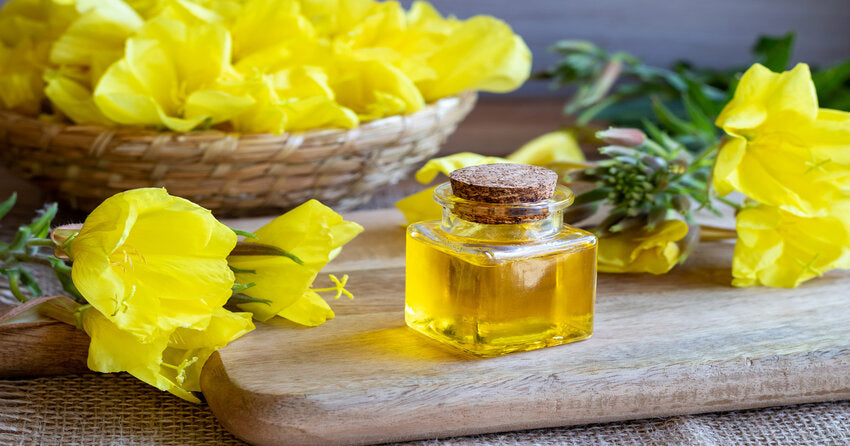3 Top Ways Evening Primrose Oil Benefits Your Health

Evening primrose (Oenothera speciosa) is a subtropical flowering plant native to North and South America and parts of Europe and Asia. Its buttery yellow flowers open at dusk, hence its name. Evening primrose grows easily in disturbed landscapes and can be found in culverts, along roadsides, and in abandoned lots – a common, though beautiful, weed.
Evening primrose has a rich history of medicinal use in Native American cultures. Different Native American tribes used the roots of evening primrose as a poultice to speed wound healing and to soothe hemorrhoids. They also used the juices from stems and leaves topically for inflammation of the skin. The roots and flowers are edible, and many Native Americans incorporated the plant into their diets. In the 17th century, Europeans began using evening primrose for various complaints, and it became known as the “King’s cure-all.”
Currently, evening primrose oil is distilled from the plant’s seeds and taken orally as a supplement to help with various ailments. In this article, we’ll look at what makes evening primrose oil beneficial to health and how it may support your wellness protocol.
What’s in Evening Primrose Oil?
Evening primrose oil contains high quantities of gamma-linolenic acid or GLA – an omega-6 fatty acid also found in human breast milk, organ meats, borage seed oil, spirulina, and black currant oil. You might be most familiar with omega-3 fatty acids, but GLA is helpful for brain function, skeletal health, and healthy skin and hair. GLA has anti-inflammatory properties, which contribute to its health benefits. Below, we’ll look at various conditions that may benefit from the use of evening primrose oil as a supplement.
Possible Benefits of Evening Primrose Oil
1. Improves Skin Health
A 2005 study looked at the impact of evening primrose oil on aging skin. Researchers evaluated the effects of oral evening primrose oil on skin qualities such as moisture, redness, firmness, water loss, elasticity, and roughness. Participants took 500mg of evening primrose oil three times a day for twelve weeks. All the categories evaluated demonstrated significant improvement, suggesting our skin needs GLA for optimal function.
2. Supports Female Hormones
A 2019 review found that evening primrose oil can be effective for various complaints associated with female hormones, such as PMS and menopausal hot flashes. However, researchers noted the effects of evening primrose oil aren’t immediate and may take four to six months to see results.
3. Supports a Healthy Inflammatory Response
Many people with long-term, inflammatory conditions explore taking evening primrose oil to limit symptoms. People suffering from joint discomfort may benefit from supplementation with the oil because GLA contains anti-inflammatory qualities.
Just about any chronic condition has an inflammatory component, so it stands to reason that evening primrose oil could be a helpful tool in many cases. Be sure to discuss supplementation with your healthcare provider to be sure it’s right for you.
Side Effects of Evening Primrose Oil
Evening primrose oil is generally safe and well-tolerated, but there are some reports of gastrointestinal upset and headaches as a result of taking the supplement. Discuss dosage with your healthcare provider and note how you feel as you begin taking it. As always, be sure to choose a reputable brand of evening primrose oil that is third-party certified for purity and doesn’t contain unhealthy additives.
Taking evening primrose oil is a relatively safe way to increase your consumption of the healthy omega-6 fatty acid GLA. GLA contains anti-inflammatory properties and is essential to various bodily functions. Taking evening primrose oil may contribute to healthier skin and more balanced hormone levels, especially in women. For people with long-term inflammatory conditions, supplementing with evening primrose oil may lower inflammation and therefore lessen symptoms, though more study is needed to understand these mechanisms fully.
Shona Curley lives and works in San Francisco. She is co-owner of the studio Hasti Pilates, and creator of the website www.redkitemeditations.com. Shona teaches meditation, bodywork and movement practices for healing Lyme disease, chronic illness, and pain.
References:
Hauben M. Comment: evening primrose oil in the treatment of rheumatoid arthritis–proper application of statistical analysis. Ann Pharmacother. 1994 Jul-Aug;28(7-8):973. doi: 10.1177/106002809402800741
Muggli R. Systemic evening primrose oil improves the biophysical skin parameters of healthy adults. Int J Cosmet Sci. 2005 Aug;27(4):243-9. doi: 10.1111/j.1467-2494.2005.00274.x





